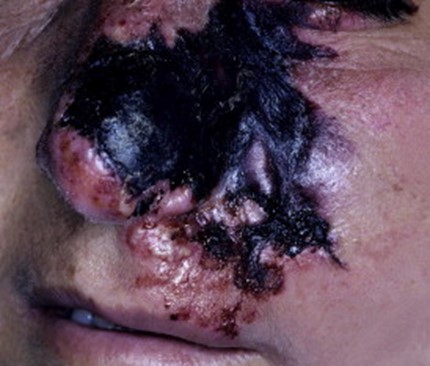INSULT TO INJURY: COVID-19-ASSOCIATED MUCORMYCOSIS
INSULT TO INJURY: COVID-19-ASSOCIATED MUCORMYCOSIS

By Warren Heymann, MD
June 9, 2021
Vol. 3, No. 23
Mucormycosis is an emergent angio-invasive mycosis caused by opportunistic fungi classified in the phylum Mucoromycota (formerly Zygomycetes). The most frequently isolated species causing cutaneous disease is Rhizopus arrhizus (formerly R. oryzae). Mucormorales are ubiquitous saprophytes gaining entry through the nasal, respiratory, and palatal mucosa, and through skin abrasion or loss of the skin barrier. In their review of 115 cases of cutaneous mucormycosis, Bonifaz et al demonstrated that 18 cases were primary and 97 secondary. Primary cutaneous mucormycosis was most frequently associated with adhesive bands (44.4%) and trauma from traffic accidents (33.3%), presenting as extensive and deep necrotic ulcers. Secondary cutaneous mucormycosis cases were rhino-cerebral with uncontrolled diabetes (81.4%), most frequently presenting as necrosis of the eyelid and the nose (65.9%). The most effective treatment was the combination of amphotericin B with surgical debridement. Clinical and mycological cure was achieved in 31.0% of primary cases and 44.4% of secondary cases. (2)

Garg et al detailed the case of a 55-year-old man with diabetes and end-stage renal disease who was diagnosed with pulmonary mucormycosis 21 days following admission for severe COVID-19 infection. He was treated successfully with liposomal amphotericin B. The authors reviewed 8 cases of COVID-19-associated mucormycosis (CAM) reporting that diabetes mellitus is the most common risk factor. Three of the 8 patients had rhinocerebral disease. In addition to diabetes, classical risk factors for mucormycosis include hematological malignancies and iatrogenic immunosuppression in transplant patients. Interestingly, 3 subjects had no risk factor other than glucocorticoid therapy for COVID-19. (3)
John et al reviewed 41 cases of CAM. The majority of cases (71%) were from India. CAM was typically seen in patients with diabetes mellitus (DM) (94%) especially patients who were poorly controlled (67%) and severe or critical COVID-19 (95%). The presentation was typical of mucormycosis seen in diabetic patients (mostly rhino-orbital and rhino-orbital-cerebral presentation). (4)
According to Alekseyev et al: "In rhinocerebral mucormycosis, the disease's hallmark is attributed to tissue necrosis from angioinvasion and subsequent thrombosis. This presents as notoriously black, necrotic eschars. The fungi gain entry via inhalation into the paranasal sinuses and may ultimately spread to the sphenoid sinus, palate and cavernous sinus. Patients may complain of blurry vision, inflammation around the orbit, sinusitis, facial pain or numbness, headache, proptosis, ophthalmoplegia, or even periorbital cellulitis." (5) The diagnosis is confirmed by imaging (CT, MRI) of the brain, sinuses, and orbit; biopsy (demonstrating inflammation, edema, thrombosis, necrosis, and coenocytic hyphae accentuated by PAS and/or GMS stains), culture, and/or PCR. (1,5).
Regarding pathogenesis of CAM, steroid therapy, which can be life-saving in viral pneumonia, may be a "double-edged sword," predisposing patients to secondary bacterial and fungal infections. (6) CAM may be related to the "endothelialitis" observed in severe COVID-19 infections. John et al opine: "Interestingly, acidemic states and hyperglycemia induce the enthodelial receptor glucose-regulated protein (GRP 78) and the Mucorales adhesin spore coat protein homologs (CotH), creating a "perfect storm" for increased adhesion and penetration of Mucorales to the endothelium. Of interest, GRP 78 has been postulated as one of the receptors responsible for SARS-CoV-2 entry." (4) Importantly, many families are self-medicating (presumably at least some with steroids) and applying oxygen therapy at home without proper hygiene. (1) These practices could predispose patients to CAM.
The paradox between the United States and India regarding COVID-19 could not be starker. I hope that by the time you read this commentary the situation in India has vastly improved, both in terms of vaccination rate and COVID-19 prevalence.
Point to Remember: Patients with severe COVID-19 infection, especially those who are diabetic, have an increased risk of developing mucormycosis. Any complaints related to the rhino-cerebral-orbital region must be assessed immediately to thwart this devasting infection.
Skin Care Physicians of Costa Rica
Clinica Victoria en San Pedro: 4000-1054
Momentum Escazu: 2101-9574
Please excuse the shortness of this message, as it has been sent from
a mobile device.

0 Comments:
Post a Comment
Subscribe to Post Comments [Atom]
<< Home